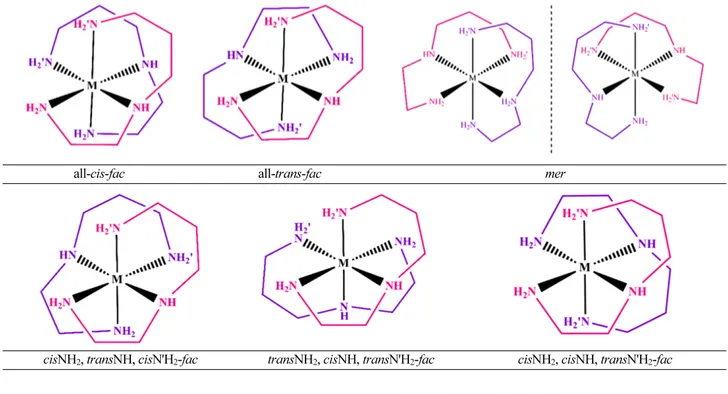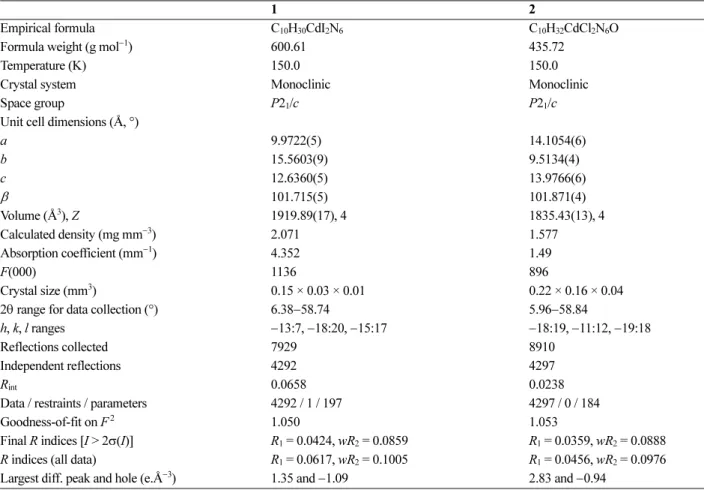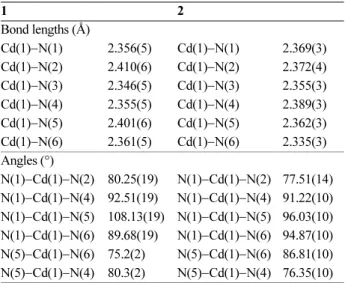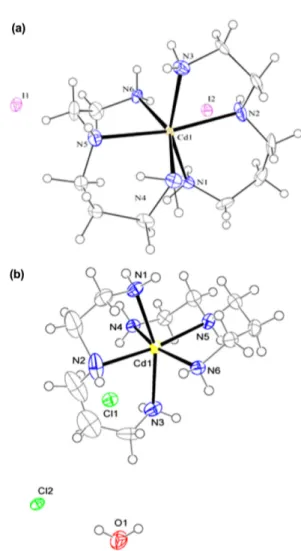Printed in the Republic of Korea
http://dx.doi.org/10.5012/jkcs.2013.57.4.447
Spectral and Geometrical Study of Two Cadmium Complexes,
mer-R,S-[Cd(aepn)
2]X
2(X: I
−, Cl
−, aepn: N-(2-Aminoethyl)-1,3-propanediamine) Supported by Solution Experiments
Mohammad Hakimi*, Zahra Mardani, and Keyvan Moeini Chemistry Department, Payame Noor University, 19395-4697 Tehran, I. R. Iran
*E-mail: mohakimi@yahoo.com
(Received June 7, 2013; Accepted July 26, 2013)
ABSTRACT. In this research, two new complexes of N-(2-aminoethyl)-1,3-propanediamine (aepn), [Cd(aepn)2]I2 (1) and [Cd(aepn)2]Cl2·H2O(2), were prepared and identified by elemental analysis, FT-IR, Raman spectroscopy and single-crystal X- ray diffraction. Geometry around the cadmium atom in two complexes by coordination of six nitrogen atoms of two aepn is distorted octahedral. If distortion in the mer-[Cd(aepn)2]2+ cation is disregarded, it has a C2 axis and C2 symmetry. The cyclic voltammetry experiments were carried out to study the complexation process. Two structural surveys on coordination modes and complexes of aepn are presented. A study was carried out using CSD data to estimate the averages of bond lengths for dif- ferent types of the Cd−N bonds. It was found that the intermolecular N–H···I, C–H···I hydrogen bonds in 1 and N–H···Cl, N–
H···O, C–H···O, O–H···Cl in 2 stabilized the crystal networks.
Key words: Cadmium complex, Chiral center, Diastereomer, Cyclic voltammetry, X-ray crystal structure
INTRODUCTION
N-(2-Aminoethyl)-1,3-propanediamine (aepn) is a rather common tridentate amine ligand. It usually forms three coordination bonds with the same central atom1−2 and only rarely aepn adopts bridging function.3 Of particular interest from the coordination chemistry perspective of the asym- metrical aepn ligand is that six diastereomers are possible in complexation,4 facials and meridionals (Table 1). The meridional conformation has a nonsuperimposable mir- ror image shown in Table 1. Although the study of geo- metrical isomerism in octahedral complexes has been a subject of cutting-edge research, the facial and meridional isomerism has been given less attention mainly due to the difficulties in the syntheses of these compounds.5
In this work preparation of two cadmium complexes [Cd(aepn)2]X2 (X: I−, Cl−) of aepn (Scheme 1) were pre- sented. These complexes were characterized by elemental analysis, FT-IR, Raman spectroscopy and X-ray crystal- lography. Cyclic voltammetry experiments were carried out in order to study the complexation process in DMSO solution.
The coordination geometry of the cadmium atom and the nature of the ligands results in the coordination num- bers of the cadmium atom in range of 2−10.6 In this paper, we endeavor to introduce new coordination aspects of the tridentate aepn with cadmium atom.
A Structural Survey on Complexes of aepn
Each tridentate ligand can be coordinated to metal in facial or meridional forms. In the mer form there are two 90o angles, one 180o but three 90o angles in fac form. Base on this principle, percentage of mer form in complexes of aepn is 91%. All complexes of aepn with fac form are including [Re(aepn)(CO)3][PF6],7 [Co(aepn)L][ClO4] (L:
(S)-aspartato-O,O',N),8 [Co(aepn)(py)2Cl][ZnCl4]9 and [Cd(aepn) (CN)3].5,10 Only one complex of aepn, [Co(aepn) (CN)3],5 with both fac and mer forms have been deposited in CSD (updated to Aug 2012).11 In 1 and 2, two angles of each aepn are deviating from 90o due to the chelating bite angle, while the third one is about 160o, to incline to the mer form.
EXPERIMENTAL
All chemicals and solvents were reagent or analytical grade and used as received. A conventional three-electrode system voltammetry was employed, with a PGSTAT101 and glassy carbon working electrode. The carbon, hydro- gen, and nitrogen contents were determined in a Thermo Finnigan Flash Elemental Analyzer 1112 EA. The infra- red spectra as KBr pellets were recorded in the range of 400–4000 cm−1 using a FT-IR 8400-Shimadzu spectrom- eter. Raman spectra were obtained using a Nicolet Model 910 Fourier-transform spectrometer. The melting points
were determined using a Barnsted Electrothermal 9200 electrically heated apparatus.
Synthesis of [Cd(aepn)2]I2, (1)
CdI2 (1 mmol, 0.37 g) was dissolved in EtOH (15 mL) and added with stirring to a solution of L(2 mmol, 0.23 g) in EtOH (5 mL). After 3 h, a white precipitate was formed, filtered and recrystallized from DMF. Colorless crystals suitable for X-ray diffraction were obtained after several days. Yield: 0.46 g, 76%. m.p. 220oC; Anal calcd for C10H30CdI2N6 (600.61): C, 20.00; H, 5.03; N, 13.99%.
Found: C, 20.06; H, 4.98; N, 14.02%; IR (KBr): 3366 m (νas NH2), 3248 s (νs NH2), 3148 m (ν NH), 2924 and 2854 m (ν CH2), 1581 m (δ NH2), 1430 w (δas CH2), 1389 w (δs CH2), 1281 and 1149 m (ν CN), 478 w (ν CdN) cm−1. Raman: 2870 m (ν CH2), 1557 w (δ NH2), 1405 s (δas CH2), 1256 w and 1108 s (ν CN), 432 m (ν CdN) cm−1.
Synthesis of [Cd(aepn)2]Cl2·H2O, (2)
The procedure for synthesis of 2 was similar to 1 except that CdI2 was replaced by CdCl2·2.5H2O and DMF by
H2O/EtOH (1:1). Yield: 0.34 g, 77%. m.p. 190oC; Anal calcd for C10H32CdN6Cl2O (435.72); C, 27.57; H, 7.40; N, 19.29%. Found: C, 27.38; H, 6.99; N, 19.33%; IR (KBr):
3456 m (νas H2O), 3382 m (νs H2O and/or νas NH2), 3279 s (νs NH2), 3194 m (ν NH), 2922 and 2870 m (ν CH2), 1597 m (δ NH2 and/or δ H2O), 1450 w (δas CH2), 1389 w (δs
CH2), 1288 and 1149 m (ν CN), 633 m (ρr H2O), 538 w (ρw
H2O), 501 w (ν CdN) cm−1. Raman: 2947 w and 2825 m (ν CH2), 1561 m (δ NH2), 1391 s (δs CH2), 1232 w and 1107 s (ν CN), 695 m (ρr H2O), 557 m (ν CdN and/or ρw H2O), 223 w (ρt H2O) cm−1.
Crystal Structure Determination and Refinement Suitable crystals of 1 and 2 were placed on Xcalibur Eos Gemini Ultra and Oxford Gemini Ultra diffractometers, respectively, and kept at 150.0 K during data collection.
Using OLEX-II,12 the structures were solved with the SHELXS13 structure solution program using Direct Meth- ods and refined with the SHELXL13 refinement package using least squares minimization.
Crystallographic data for the structures reported here have been deposited with CCDC (Deposition No. CCDC- 913890 (1) and 913894 (2)). These data can be obtained free of charge via http://www.ccdc.cam.ac.uk/conts/retrieving. html or from CCDC, 12 Union Road, Cambridge CB2 1EZ, UK, E-mail: deposit@ccdc.cam.ac.uk.
Table 1. Six possible diastereomers for coordination of two aepn in octahedral geometry. The meridional conformation has a nonsuper- imposable mirror image
all-cis-fac all-trans-fac mer
cisNH2, transNH, cisN'H2-fac transNH2, cisNH, transN'H2-fac cisNH2, cisNH, transN'H2-fac
Scheme 1. The structure of aepn.
RESULTS AND DISCUSSION
A study using CSD data showed that complexes of Cr,14 Co,15 Ni,16 Cu,17 Zn,10 Cd2 and Re7 with aepn have been reported previously. All coordination modes of aepn are presented in Table 2. Among these modes, Two-chelate form which was observed in 1 and 2 is most frequent.
Reaction between aepn and ethanolic solution of cad- mium(II) iodide and chloride in a molar ratio of 1:2 (M:L) give 1 and 2, respectively. These complexes are air-stable and soluble in DMSO and DMF.
Spectroscopic Characterization
In the IR spectra of 1, 2 and aepn, the bands above 3100 cm−1 were assigned to vibrations of the νas (NH2), νs
(NH2) and ν (NH).18 Also the NH2 bending vibration appears near 1600 cm−1 in these compounds. Presence of
the water molecule in 2 affects the IR and Raman spectra in the three regions including 3456 and 3382 cm−1 respec- tively for asymmetric and symmetric OH stretches, 1597 cm−1 for H2O bending and 200–600 cm−1 for “librational modes”. These modes are due to rotational oscillations of the water molecules restricted by interactions with neigh- boring atoms and they are classified into three types (wag- ging (ρw), twisting (ρt) and rocking (ρr)) depending upon the direction of the principal axis of rotation.19 In the IR and Raman spectra of 2, vibrations such as νs (H2O), δ (H2O) and ρw (H2O) overlapped with vibrations due to the νas (NH2), δ (NH2) and ν (CdN) respectively.
Information about the low-frequency vibrations of metal- ligand bonds can be obtained by Raman spectroscopy.20 In the Raman spectrum of 1, a band at 432 cm−1 was assigned to the Cd–N stretching vibrations. In the Raman spectrum of 2, similar band was observed at 557 cm−1. These assign- Table 2. Different types of coordination modes of aepn collected by ConQuest.28
Coordination modes of aepn
Name One-chelate form Two-chelate form Helicated form
Number of deposited structures 2 71 1
Coordinated metals Co,29 Ni29 Cr,14 Co,15 Ni,16 Cu,17 Zn,10 Cd,2 Re7 Cd3
Figure 1. The current-potential curves of DMSO solution of 0.01 M Cd2+ containing 0.1 M TBAP in the absence and presence of increasing concentrations of aepn. After each addition, reaction mixture was stirred at 60oC for 1 h.
ments are in consistent with values reported in the liter- ature.4
Cyclic Voltammetry Experiments
The experiments of cyclic voltammetry were investi- gated in DMSO solution containing 0.10 M TBAP (tet- rabutylammonium perchlorate) and 0.01 M reagents using Ag/AgCl as reference electrode at room temperature, in potentials range of +1.5 to –2.9 V with a scan rate of 50 mV s−1 and starting voltage –2.9 V. The cyclic volta- mmogram of aepn shows an irreversible anodic wave near +0.9 V which can be attributed to the oxidation of the groups present in the aepn (Fig. 1).
The cyclic voltammogram of Cd2+ solution displays two reduction waves at the negative potential region, –1.309 V and –1.705 V which are corresponding to Cd(II)/Cd(I) and Cd(I)/Cd(0) process, respectively.21−23 Addition to these waves, there is one oxidation wave at –0.746 V (Fig. 1) which appears with measuring in the opposite directions thus it is not corresponding to Cd(I)/Cd(II) process. Fig. 1 shows the current-potential curves of 0.01 M solutions of Cd2+ (using the cadmium chloride salt) either with or without
increasing concentrations of aepn. The waves corresponding to the Cd(I)/Cd(0) process were deleted for clarity. With increasing concentration of aepn, the cathodic wave is shifted slightly to more negative values, whereas that of the oxi- dation slightly is disappeared. These observations dem- onstrate that the electrochemical behavior of Cd2+ solution is strongly affected by aepn. The potentials shift, indicat- ing the formation of a cadmium complex with aepn. The cathodic wave have no more shift upon the 2.5:1 (L:M) ratio which suggests that the cadmium ion and aepn reach a state of coordination equilibrium. Also one anodic wave near +0.9 V (Fig. 1) corresponding to the oxidation of the free aepn appears after this ratio and increases with accen- tuating of L:M ratio. These results demonstrate that max- imum of eight coordination site of Cd2+ ion in DMSO solution can be occupied by 2.5 molecules of aepn.
The acid dissociation constants of the three amino groups of aepn and stability constants for this ligand with Co(II), Ni(II), Cu(II), Zn(II) and Cd(II) have been previously reported.24 As expected, the values of formation constant for 1:2 (M:L) complexes considerably are higher than those of 1:1 (M:L).
In 1:1 (M:L) reaction condition which of the species,
Table 3. Crystal data and structure refinement for 1 and 2.
1 2
Empirical formula C10H30CdI2N6 C10H32CdCl2N6O
Formula weight (g mol−1) 600.61 435.72
Temperature (K) 150.0 150.0
Crystal system Monoclinic Monoclinic
Space group P21/c P21/c
Unit cell dimensions (Å, °)
a 9.9722(5) 14.1054(6)
b 15.5603(9) 9.5134(4)
c 12.6360(5) 13.9766(6)
β 101.715(5) 101.871(4)
Volume (Å3), Z 1919.89(17), 4 1835.43(13), 4
Calculated density (mg mm−3) 2.071 1.577
Absorption coefficient (mm−1) 4.352 1.49
F(000) 1136 896
Crystal size (mm3) 0.15 × 0.03 × 0.01 0.22 × 0.16 × 0.04
2θ range for data collection (°) 6.38−58.74 5.96−58.84
h, k, l ranges −13:7, −18:20, −15:17 −18:19, −11:12, −19:18
Reflections collected 7929 8910
Independent reflections 4292 4297
Rint 0.0658 0.0238
Data / restraints / parameters 4292 / 1 / 197 4297 / 0 / 184
Goodness-of-fit on F2 1.050 1.053
Final R indices [I > 2σ(I)] R1 = 0.0424, wR2 = 0.0859 R1 = 0.0359, wR2 = 0.0888 R indices (all data) R1 = 0.0617, wR2 = 0.1005 R1 = 0.0456, wR2 = 0.0976
Largest diff. peak and hole (e.Å−3) 1.35 and −1.09 2.83 and −0.94
[Cd(aepn)]2+ and/or [Cd(aepn)2]2+, are formed in solu- tion? The cyclic voltammetry experiments can answer to this question. The formation of [Cd(aepn)]2+ ion is confirmed, although [Cd(aepn)2]2+ ion is more stable than [Cd(aepn)]2+, owning to the position of one reduction wave (Cd(II)/Cd(I)) in the curve of 1:1 (M:L) ratio as illustrated in Fig. 1. The crystal structure of 1:1 (M:L) ratio, [Cd2(aepn)2Cl4], has been reported previously.2
Description of the Crystal Structures
The diagrams of the molecular structures and unit cells were created using ORTEP-III25 and Diamond (version 3.2g)26 softwares. Table 3 contains crystallographic data and details of the data collection and structure refinement.
Selected bond lengths (Å) and angles (°) and dimensions of the hydrogen bonds (Å and °) for complexes are listed in Tables 4 and 5, respectively.
In the crystal structure of 1 and 2 (Fig. 2), cadmium atom with coordination number six has a distorted octa- hedral geometry. Four sites of this geometry are occupied by nitrogen atoms of the NH2 groups with the Cd–N bond lengths in the range of 2.346(5)–2.361(6) and 2.335(3)–
2.389(3) Å for 1 and 2, respectively. The two other sites are occupied by nitrogen atoms of the NH groups with the Cd–N bond lengths in the range of 2.401(6)–2.410(6) and 2.363(3)–2.373(3) Å for 1 and 2, respectively. To esti- mate the bond lengths averages for different types of the Cd−N bond a study was carried out using CSD data and the results are listed in Table 6. Based on this study, the Cd–Nimine distance is shorter than the other types of the Cd–N bonds while the Cd–NR3 distance is among the longest. Similar results were also observed in 1 and 2 for distances average.
Two aepn in 1 and 2, which act as tridentate forming two Table 4. Selected bond lengths (Å) and angles (°) for 1 and 2
1 2
Bond lengths (Å)
Cd(1)−N(1) 2.356(5) Cd(1)−N(1) 2.369(3) Cd(1)−N(2) 2.410(6) Cd(1)−N(2) 2.372(4) Cd(1)−N(3) 2.346(5) Cd(1)−N(3) 2.355(3) Cd(1)−N(4) 2.355(5) Cd(1)−N(4) 2.389(3) Cd(1)−N(5) 2.401(6) Cd(1)−N(5) 2.362(3) Cd(1)−N(6) 2.361(5) Cd(1)−N(6) 2.335(3) Angles (°)
N(1)−Cd(1)−N(2) 80.25(19) N(1)−Cd(1)−N(2) 77.51(14) N(1)−Cd(1)−N(4) 92.51(19) N(1)−Cd(1)−N(4) 91.22(10) N(1)−Cd(1)−N(5) 108.13(19) N(1)−Cd(1)−N(5) 96.03(10) N(1)−Cd(1)−N(6) 89.68(19) N(1)−Cd(1)−N(6) 94.87(10) N(5)−Cd(1)−N(6) 75.2(2) N(5)−Cd(1)−N(6) 86.81(10) N(5)−Cd(1)−N(4) 80.3(2) N(5)−Cd(1)−N(4) 76.35(10)
Table 5. Dimensions of the hydrogen bonds (Å and °) in 1 and 2
D−H···A d(D−H) d(H···A) <(DHA) d(D···A) Symmetry code on A atom
1 N(1)−H(1A)···I(2) 0.900 2.8885 161.3 3.752(5) 1 − x, 1 − y, 1 − z
N(1)−H(1B)···I(2) 0.900 3.0507 157.2 3.896(6) x, y, z
N(3)−H(3AA)···I(1) 0.899 2.8982 148.2 3.693(6) x, 0.5 − y, 0.5 + z
N(3)−H(3AB)···I(1) 0.899 3.0199 131.9 3.681(5) 2 − x, 0.5 + y, 1.5 − z
N(5)−H(5)···I(1) 0.911 3.0321 156.6 3.885(5) 2 − x, 0.5 + y, 1.5 − z
N(6)−H(6A)···I(1) 0.900 2.8984 163.4 3.770(5) x, 0.5 − y, 0.5 + z
N(6)−H(6B)···I(2) 0.900 2.8278 161.8 3.693(5) x, y, z
C(3)−H(3A)···I(2) 0.969 3.1505 173.9 4.115(8) 1 − x, 0.5 + y, 1.5 − z
2 N(1)−H(1A)···Cl(1) 0.900 2.6206 159.4 3.477(3) −1 + x, 0.5 − y, −0.5 + z
N(1)−H(1B)···Cl(2) 0.900 2.4777 162.7 3.348(3) 1 − x, −0.5 + y, 1.5 − z
N(2)−H(2)···Cl(2) 0.910 2.5121 154.8 3.357(3) 1 − x, 1 − y, 1 − z
N(3)−H(3A)···Cl(1) 0.900 2.5050 171.6 3.398(3) x, y, z
N(4)−H(4A)···Cl(1) 0.900 2.5733 154.9 3.410(3) x, y, z
N(4)−H(4B)···Cl(2) 0.900 2.5051 168.7 3.392(3) 1 − x, −0.5 + y, 1.5 − z
N(5)−H(5)···Cl(1) 0.909 2.5056 173.0 3.410(3) 1 − x, −y, 1 − z
N(6)−H(6A)···Cl(2) 0.900 2.6809 164.3 3.556(3) 1 − x, 1 − y, 1 − z
N(3)−H(3B)···O(1) 0.900 2.430 142.7 3.193(5) 1 − x, −0.5 + y, 0.5 − z
N(6)−H(6B)···O(1) 0.899 2.159 167.3 3.043(4) 1 − x, −0.5 + y, 0.5 − z
O(1)−H(1E)···Cl(1) 0.850 2.430 161.7 3.248(4) 1 − x, 1 − y, 1 − z
O(1)−H(1F)···Cl(1) 0.849 2.3801 153.97 3.165(4) x, 0.5 − y, −0.5 + z
C(3)−H(3C)···O(1) 0.971 2.685 121.0 3.293(8) 1 − x, 1 − y, 1 − z
five- and two six-membered chelate rings with the cad- mium atom and neither are planar. The dihedral angle between the two N1/N2/N3/Cd1 and N4/N5/N6/Cd1 plans in 1 and 2 is 89.65o and 89.55o, respectively that confirm the mer form. mer-[Cd(aepn)2]2+ has a nonsuperimposable mirror image (Table 1) which is observed in the crystal structure of 1 and 2. If the distortion in the [Cd(aepn)2]2+ cation is disregarded, it has a C2 axis and C2 symmetry (Scheme 2) and must be optically active but the unit cells of 1 and 2 contain racemic mixture and are non-optically active. The
aepn has no chiral center but two new ones (N2, N5) are formed after coordination27 with different enantiomeric Figure 2. The ORTEP-III diagrams of the molecular structure of
1 (a) and 2 (b). The ellipsoid is drawn at the 40% probability level.
Table 6. Bond distances for different types of the Cd−N bonds. The term “py-b” refers to all pyridine-based compounds and “R” refers to each carbon atom which can be connected to any atoms with single, double or triple bonds
Type
Cd−N distance (Å) 2.307 2.326 2.341 2.354 2.376 2.457
Scheme 2. Showing C2 symmetry in complexes of 1 and 2.
Figure 3. Packing of 1, showing the hydrogen bonds. Only the hydrogen atoms involved in hydrogen bonding are shown. Each CdN6 unit is shown as an octahedron.
forms.
In the crystal network of 1 (Fig. 3), there are intermo- lecular N–H···I and C–H···I hydrogen bonds (Table 5). In hydrogen bonding, the iodide atoms act as proton accep- tors whereas the carbon and nitrogen atoms participate as proton donors. Also the hydrogen bonds including N–H···Cl, N–H···O, C–H···O and O–H···Cl stabilized the crystal net- work of 2 (Fig. 4).
CONCLUSION
Two new complexes, [Cd(aepn)2]I2 and [Cd(aepn)2]Cl2·H2O, were synthesized in reaction between cadmium(II) iodide and chloride with aepn, N-(2-aminoethyl)-1,3-propanedi- amine, respectively. For these complexes spectral (IR, Raman), electrochemical and structural properties were investigated. Cadmium atom in two complexes has a dis- torted octahedral geometry by coordination of six nitrogen atoms of two aepn. The complexes have meridional con- formation and C2 symmetry and must be optically active but the unit cells of 1 and 2 contain a racemic mixture and are non-optically active. The aepn has no chiral center but two new ones (N2, N5) are formed after coordination with different enantiomeric forms. A survey on complexes of aepn showed that this ligand has three coordination modes
including One-chelate, Two-chelate and Helicate forms.
Among these modes, the Two-chelate mode which was observed in 1 and 2 is most frequent. A study of CSD data showed that the Cd–Nimine and Cd–NR3 distances respec- tively are shorter and longer than the other types of Cd–N bonds. Similar results were observed in 1 and 2. The inter- molecular N–H···I, C–H···I hydrogen bonds in 1 and N–H···Cl, N–H···O, C–H···O, O–H···Cl in 2 stabilized the crystal net- work of these complexes.
Acknowledgments. We are grateful to Payame Noor Uni- versity of I. R. Iran for the financial support of this research project. And the publication cost of this paper was sup- ported by the Korean Chemical Society.
REFERENCES
1. Bartoszak-Adamska, E.; Bregier-Jarzebowska, R.; Lomozik, L. Polyhedron 2002, 21, 739.
2. Cannas, M.; Marongiu, G.; Saba, G. J. Chem. Soc. Dalton Trans. 1980, 2090.
3. Mondal, A.; Mostafa, G.; Ghosh, A.; Chaudhuri, N. R. J.
Chem. Res. 1998, 570.
4. Hakimi, M.; Mardani, Z.; Moeini, K.; Fernandes, M. A.
J. Coord. Chem. 2012, 65, 2221.
5. Chun, H.; Maes, E. M.; Czernuszewicz, R. S.; Bernal, I.
Polyhedron 2001, 20, 2597.
6. Hakimi, M.; Moeini, K.; Mardani, Z.; Schuh, S.; Mohr, F.
J. Coord. Chem. 2013, 66, 1129.
7. Perera, T.; Marzilli, P. A.; Fronczek, F. R.; Marzilli, L. G.
Inorg. Chem. 2010, 49, 5560.
8. Kratochvil, B.; Ondracek, J.; Ondrackova, J.; Soldanova, J.; Jursik, F.; Hajek, B. Collect. Czech. Chem. Commun.
1987, 52, 949.
9. House, D. A.; Browning, J.; Zipper, L.; Marty, W. Inorg.
Chim. Acta 1999, 288, 181.
10. Paharova, J.; Cernak, J.; Zak, Z.; Marek, J. J. Mol. Struct.
2007, 842, 117.
11. Allen, F. H. Acta Crystallogr. 2002, B58, 380.
12. Dolomanov, O. V.; Bourhis, L. J.; Gildea, R. J.; Howard, J. A. K.; Puschmann, H. J. Appl. Crystallogr. 2009, 42, 339.
13. Sheldrick, G. M. Acta Crystallogr. 2008, A64, 112.
14. Derwahl, A.; Robinson, W. T.; House, D. A. Inorg. Chim.
Acta 1996, 247, 19.
15. Ishii, M.; Sato, S.; Saito, Y.; Nakahara, M. Chem. Lett.
1981, 1613.
16. Wen, R.; Somoza, F.; Bernal, I.; Fronczek, F. R. J. Coord.
Chem. 1999, 48, 443.
17. Escuer, A.; Font-Bardia, M.; Penalba, E.; Solans, X.; Vice- nte, R. Inorg. Chim. Acta 1999, 286, 189.
18. Hakimi, M.; Maeder, M.; Lawrance, G. A. J. Coord. Chem 2011, 64, 105.
Figure 4. Packing of 2, showing the hydrogen bonds. Only the hydrogen atoms involved in hydrogen bonding are shown. Each CdN6 unit is shown as an octahedron.
19. Hakimi, M.; Mardani, Z.; Moeini, K.; Mohr, F.; Schuh, E.; Vahedi, H. Z. Naturforsch. 2012, 67b, 452.
20. Hakimi, M.; Mardani, Z.; Moeini, K.; Minoura, M.; Raissi, H. Z. Naturforsch. 2011, 66b, 1122.
21. Deveci, P.; Taner, B.; Klllç, Z.; Solak, A. O.; Arslan, U.;
Özcan, E. Polyhedron 2011, 30, 1726.
22. López-Torres, E.; Mendiola, M. A. Polyhedron 2005, 24, 1435.
23. Feng, X.; Li, Z.-F.; Xue, S.-F.; Tao, Z.; Zhu, Q.-J.; Zhang, Y.-Q.; Liu, J.-X. Inorg. Chem. 2010, 49, 7638.
24. Martell, A. E.; Smith, R. M.; Motekaites, R. J. NIST Cri-
ticially Selected Stability Constants of Metal Complexes, V. 8.0; NIST: Gaithersburg, MD; 2004.
25. Farrugia, L. J. J. Appl. Crystallogr. 1997, 30, 565.
26. Bergerhoff, G.; Berndt, M.; Brandenburg, K. J. Res. Natl.
Inst. Stand. Technol. 1996, 101, 221.
27. Hakimi, M.; Moeini, K.; Mardani, Z.; Fernandes, M. A.;
Mohr, F.; Schuh, E. J. Coord. Chem. 2012, 65, 1232.
28. ConQuest 1.14, Cambridge Crystallographic Data Centre:
Cambridge, U.K.; 2012.
29. Antonova, E.; Nather, C.; Kogerler, P.; Bensch, W. Inorg.
Chem. 2012, 51, 2311.





